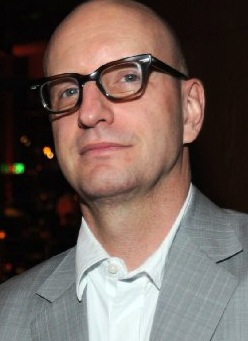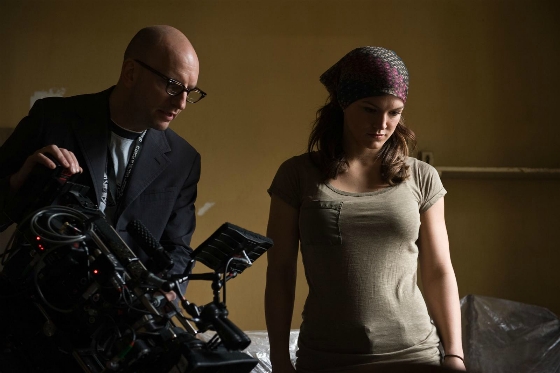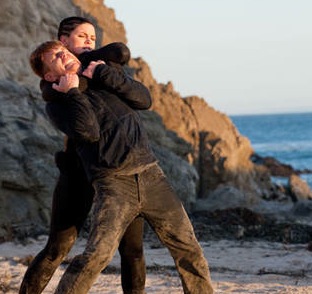 Since his Sundance breakout sex, lies and videotape, Steven Soderbergh has always been a risk taker, crafting movies born from his own interests and executing them in a fashion perfectly in tune with his sensibilities.
Since his Sundance breakout sex, lies and videotape, Steven Soderbergh has always been a risk taker, crafting movies born from his own interests and executing them in a fashion perfectly in tune with his sensibilities.
His latest movie, Haywire, an old school spy thriller, started with its lead: MMA fighter Gina Carano. Much like his previous films that have taken the untraditional route of casting non-actor leads, Soderbergh peppers his tense, dynamic action flick with big name players. Ewan McGregor, Michael Fassbender, Michael Douglas, Antonio Banderas, Bill Paxton and Channing Tatum duke it out with Carano, a brilliant discovery from whom Soderbergh harvested brutal fights and charismatic dialogue.
I had a chance to sit down with Soderbergh to discuss the ins and outs Haywire (you may have already seen a snippet of our discussion on his upcoming projects), on crafting a movie around an athlete, separating a spy movie from the countless others in existence and making a fight scene kick ass:
Conceiving Haywire:
Steven Soderbergh: It really was because of [Gina]. If she had said no, then I wouldn’t have thought, “oh, well I still want to go and do this.” She was the reason to do the movie for me. That’s why I called Lem. Immediately I thought, oh, in terms of its tone, it should be sort of like The Limey. It should be sort of terse, very lean. i liked the idea of a fractured narrative that had a loop you finally caught up to. I just called him up and said, go on YouTube, check out this woman. It’s pretty straightforward. The idea was, she’s in the private security world, she’s working for one of those Blackwater type companies. Something goes wrong, she’s got to go on the run, and sort of beat her way through the cast. You’re just looking for a sort of simple construct. It didn’t take us long to sort of figure out what the basic shape of it was.
I knew we had to look at her as a female version of Clint Eastwood. The character had to be sort of in that vein. We didn’t need her to burst into tears or deliver a two-page monologue, she just need to be cool. The thing that really convinced me is I saw her interviewed, and I really liked her. She’s really genuine, very unpretentious. She seemed resolutely grounded and charming. She’s a very ebullient personality, and she didn’t really get much opportunity to do that here. She just had a great vibe. She was very watchable.
The tone of Haywire‘s spy story:
Soderbergh: I had an idea in the back of my mind, I was thinking it would be fun to do a movie like the early Bond films, or like the Harry Palmer films, which I liked a lot, and nobody talks about anymore. But it was kind of, well it’s not going to be a Bond film, and the idea of trying to create a new Bond character is difficult. They did it with the Bourne films, but the aesthetic is the opposite of this. When I saw her, which is completely by chance- if I don’t land on this channel, none of this happens. That’s when I thought, oh, well now I can combine her with this idea. Now that’s interesting. Now I’ve sort of takens something that somebody’s done before and moved it a little bit this way.
The star-studded ensemble:
Soderbergh: It wasn’t just a matter of A-list talent. It had to be A-list talent who could go toe-to-toe with her. I had to have three guys who could really fight with her. I knew Channing could do that, I knew Fass could do it, and then I had Obi-Wan Kenobi. [Ewan McGregor] really wanted to do [his big fight scene].
Putting a woman into the action:
Soderbergh: The point was, to me, to in essence de-genderize her, and to not be patronizing by treating her any differently than I would a male character. That was my attitude. Don’t do anything with her you wouldn’t do with a guy. It would be insulting to tell the guys, don’t hit her in the face because she’s a woman. I asked Fassbender when I sent him the script, ‘are you going to have a problem hitting a woman in the face as hard as you can?’ and he laughed and said ‘I don’t think so.’ You’ve got to be that guy, as did Channing. I felt like it was time. And I liked that she takes it and she dishes it out, and Gina would be the first person to say, you have to do it this way. And she was also the person on the set saying “you have to hit me harder.”
 She’s operating in this world completely dominated by men. Her future is largely determined by the decisions these men make for her. It’s an interesting layer to have in the movie without even talking about it. She has to be smarter than everyone else in order to survive. I liked that there was this personal aspect to the whole Kenneth decision to throw her under the bus. If I can’t have her, nobody can have her. Michael Fassbender’s character sort of picks up on that and tries to a dress it, and Ewan kicks it to the curb. I liked that part of it, and I was very conscious of not wanting to turn her into a Fembot. I think she’s sexy in the movie, but it’s because Gina’s sexy.
She’s operating in this world completely dominated by men. Her future is largely determined by the decisions these men make for her. It’s an interesting layer to have in the movie without even talking about it. She has to be smarter than everyone else in order to survive. I liked that there was this personal aspect to the whole Kenneth decision to throw her under the bus. If I can’t have her, nobody can have her. Michael Fassbender’s character sort of picks up on that and tries to a dress it, and Ewan kicks it to the curb. I liked that part of it, and I was very conscious of not wanting to turn her into a Fembot. I think she’s sexy in the movie, but it’s because Gina’s sexy.
I just think there’s something more fun about it, just because things are harder for them. Men run everything, so they have another thing to deal with that we don’t have to deal with. That’s just from a directorial standpoint, that’s fun. And there are a couple of great female characters in the film we’re doing this spring, Bitter Pill. It makes you realize people just aren’t writing a lot of great roles for woman. They haven’t been afor a while, they certainly aren’t now. In business now, everyone’s running numbers and doing projections, and there are one or maybe two women that mean anything, and that’s just horrible.
Directing the film’s exhilarating fight scenes
Soderbergh: I had to do some studying. I had a sense of what I didn’t want to do. I didn’t want to do it handheld, and I didn’t want to have the shots so big and fast you didn’t know where you were. I didn’t want to cheat, because I didn’t have to cheat. Immediately that determines a lot. When you start talking about rules of movement, composition and lens length, already you’re starting to dial in what kind of shots you can use. Then it’s strictly dictated by, look, when you’re watching action you’re just looking for if there are more than one or two elements in the frame, you’re trying to analyze the intersecting plans of movement.
Then the dispersal of energy, where is the energy going in the scene. you’re trying got figure out where the camera should be to figure out that dispersal of energy the most. I’m trying got figure out how long can I hold this shot before it falls apart, before they can’t do it anymore. Because they’re not actually hitting each other, it may look great until they twist and you can tell they’re faking that punch. That shot [in the hotel scene] where they come through the door, which was the first take and the only take, we rehearsed it rehearsed it rehearsed it, I knew if they do it right I can carry it all the way to him throwing her on the floor. They came in, and not only did they get it right, they crashed into that lamp, which was not planned. Then he threw her out of frame, and we got it. I was able to throw it that long because of the two of them.
There’s a lot of Foley artists hitting clay and shit. The reality of it wouldn’t be quite that good, but I didn’t want it to be Raiders of the Lost Ark, where the punch sounds like a cannon. I knew there’s not going to be any music, it’s just going to be sound effects. It has to feel as real as the images do.
The slick score by Ocean’s 11 composer David Holmes:
Soderbergh: That was interesting. I went through a couple of different approaches early with the temp. I went to David and said I don’t want at traditional action score. We started talking about lalo Schifferin, who did Bullitt and the Mission: Impossible theme. He’s a really great composer. There’s this great music cue in Bullitt called “Shifting Gears” and it ahd these great horns. I started getting really obsessed with horns. It’s a specific kind of horn, it’s a jazz horn, they’re all mid and low. the baritone. He really ran with that, which is great. But I’m really happy with it, because it feels, the score needed to sound like her more than sounding like the kind of movie it is. It needed to sound more like her than it sounds like the genre. I wanted it to be more closely bound to what she feels like than what this kind of movie feels like in general. Those were the conversations I had with David. It needs to feel like her.
 The scenes in Haywire he finds most satisfying:
The scenes in Haywire he finds most satisfying:
Soderbergh: I really liked the beach scene because we made a choice there that was a tricky choice to make. If we hadn’t shot everything else, I couldn’t have made it. In the hotel room scene we had two full shooting days, two normal 10-hour shooting days. With the beach scene, I wanted it to be occurring the moment where the sun is about to go down. In any given day, there’s only about 45 minutes in which you can sell that. That meant I had to shoot that sequence in two days, in two 45-minute windows. No sane person would say “let’s do that.” It’s nuts, especially if you’re not storyboarding or whatever. I got Gina and Ewan out there. Thorughout the sequence the sun is supposed to be getting lower and lower, and there are certain shots in which that’s very obvious, and certain shots in which that’s not obvious at all.
Testing his movies for audiences before release:
Soderbergh:Oh, it tested terribly, because it’s non-linear. Non-linear movies test terribly, always. You have to understand what the dynamic of a preview is. People in the audience feel like they’re being tested. When you do a nothing that isn’t sort of down the middle, your scores start to go down. That happened on Out of Sight, same kind of scores as this. I knew we were in trouble, they have the test and pull 20 people and do a focus group. Then somebody stands up and starts asking specific questions.
I remember going to the test of Out of Sight, and before the guy even got started, somebody raised their hand and said ‘I just want to say, I hate stories that are told this way.’ And it got worse form there. This guy opened the floodgates, and they just trashed it. That might be the least flawed movie I’ve made, and they just hated it. You’ve got o be smart about what you use it for. The industry is littered with films that have scored in the 90s that tanked, movies that are classics that scored terribly. I’ve seen this happen, a movie will get a middling score, a 72 or something, and people feel like, “72, I bet we can move it.” I saw this happen on a movie, it wasn’t mine but I was working at a poster facility where this was happening next door to me. They did radical stuff to this movie, reshoots, rescore—72. They did another round of crazy re-editing, another score, reshoots—72. It was clear, this movie’s a 72. And I’ve realized that i’ve never had the experience of doing two tests where the scores went crazy up or down. It’s invariably, and maybe it’s the kind of films we make, there’s something in their DNA that’s never going to be changed, no matter how you mess around.
Shooting second unit (additional action scenes) for the upcoming The Hunger Games:
Soderbergh: It wasn’t any bigger than an Ocean’s movie. I’m glad I wasn’t directing it. My two days were pretty specific. And it was something Gary [Ross, director] and I had talked about in March, because we’ve known each other a long time. He’s done me a lot of favors. He’s one of the people I call to show things to who doesn’t hesitate to tell me what’s wrong. To his credit, he offers to roll his sleeves up and be part of the solution. In March and April, when he got the board, he knew immediately– ‘I’ve got two days at the beginning of August, second unit days, I’m going to need to hire someone to come and do these. What is your schedule going to be’ I said, ‘Oh that’s perfect.’ That was all done months ago.
The lessons he learned from actor/collaborator Spalding Gray (who was also the subject of the Soderbergh’s 2010 documentary And Everything Is Going Fine):
Soderbergh: What I learned…what was confirmed by Spalding, and is something you should always remember, is two things: one is the discipline. How hard it is to be good at something. It requires relentless effort. If you slack off at all, it will figure that out and it will destroy you, the piece. And that combined with his ability to make something that I knew from seeing the other side of it was really difficult, look easy. He never burdened the audience with the difficulty of the process. That’s something I believe in too. I’m glad people think the Ocean’s movies look like I just tossed them off. I’m glad it feels that way, because I didn’t. What happened to him was just bad luck, terrible, random. A tragedy [Gray drowned in 2008].
His own fight history:
Soderbergh: I used to get in a lot of fights. It was kind of the way all kids fight, it dissipated into chaos pretty quickly. I went through this period in like third and fourth grade, where I was getting into fights or willing to get into fights, and then it passed. I don’t know what that was about, I really don’t. It’s like when I was 12. I went through a six-month shoplifting phase. I stole everything.
I stole a lot of books. It wasn’t like my friends were doing it, it wasn’t a peer pressure thing, I was alone. Nobody knew. I wasn’t sharing this with anyone. I just went through this six months in Virginia of stealing. I was in a department store when the power went out—this was 1975, before all the technology—I walked out there 30 pounds heavier than when I walked in. I stole a tennis racket. In the woods walking home, I just got rid of it all. It wasn’t shit I needed.
=”font-style:>


